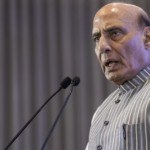
SOURCE: INDIA TODAY
The Indian Army today accused the PLA of firing in the air to intimidate its soldiers on the evening of September 7. This would be the first time bullets were fired along the Line of Actual Control (LAC) between India and China in 45 years.
The army says PLA troops attempted to close in on one of its forward positions along the LAC in the Chushul sub-sector and ‘fired a few rounds in the air’ to intimidate Indian soldiers. The last time shots were fired was on October 20, 1975 when the PLA ambushed an Assam Rifles patrol in Tulung La in Arunachal Pradesh, killing four soldiers. Article VI of the Military confidence building measures (CBMs) signed between India and China in November 1996 explicitly forbids the discharge of firearms within 2 km of the Line of Actual Control.
On Monday night, a spokesperson for China’s Western Theatre Command which oversees the Tibet and Xinjiang military districts, accused Indian troops of ‘brazenly making gunshot threats to the patrolling Chinese border guards who came forward for negotiations’.
The negotiating team might not have been unarmed. Photographs released today by the Indian military showed PLA soldiers near its positions in Chushul armed with Guangdongs, a medieval Chinese polearm superficially resembling ice-hockey sticks. Earlier, PLA soldiers were armed with spiked clubs in Galwan where 20 Indian soldiers were killed on June 15. The rhetoric has sharply escalated over the past ten days with the Chinese side repeatedly accusing India of transgressing the LAC.
Both sides have been eyeballing each other since the night of August 29 when the Indian Army occupied strategic heights south of the Pangong lake. These heights have, for the first time in decades, brought Chinese positions including its Moldo garrison, within the Indian Army’s line of sight.
The Army says it ‘thwarted Chinese intentions to alter the ground situation’ by occupying strategic heights within the LAC in the Chushul sub-sector. The Indian Army’s official term for ita ‘quid pro quo’ move (better explained as tit-for-tat)–is aimed at giving India leverage in talks with China to withdraw behind Finger 4 in Pangong Tso where it has come in 8 km into the buffer zone, and from Gogra Post near the Galwan Valley where it has obstructed the army from reaching Patrol Post 17A. Over a dozen rounds of talks over the past two months have failed to get the PLA to disengage from these two friction points. A two-and-a-half hour dialogue between defence minister Rajnath Singh and his Chinese counterpart Wei Fenghe in Moscow on September 4 also failed to break the deadlock.
Attention has now shifted to the next high-level exchange between the two sides—the upcoming meeting of external affairs minister S. Jaishankar and his Chinese counterpart Wang Yi on the sidelines of the Shanghai Cooperation Organisation meeting in Moscow on Friday. While Jaishankar stressed that diplomacy and talks were the only way forward, New Delhi has subtly hinted that it is using all military options available, both overt and covert. It has deployed units of the Special Frontier Force, a covert military unit under the Cabinet Secretariat comprising ethnic Tibetans, to man some of the heights in Ladakh. This is the first time in several decades that the SFF has been deployed along the LAC with China. In yet another not-so-subtle signal on Monday, BJP leader Ram Madhav attended a public funeral in Leh of SFF soldier Nyima Tenzin. Tenzin was part of the operation on the night of August 29 and had died after stepping on a landmine planted during the 1962 war.






